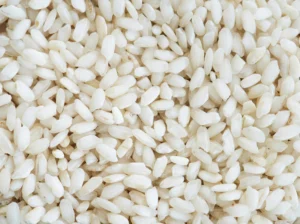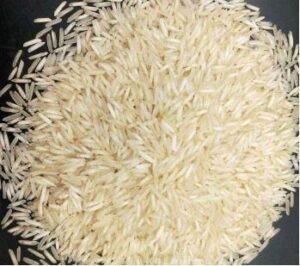
Overview
People love to eat rice and depend on different types of food grains as feed sources. Rice is produced and cultivated in different regions of Pakistan. A rice grain is the starchy, edible seed of the rice plant, a staple food for billions of people worldwide. Rice is a cereal grain categorized by its length into three categories: short, medium, and long, each with distinct textures. Common varieties are long-grain basmati rice, nutty brown rice, jasmine, and versatile sushi rice.
In this article, we’ll review rice grain, its characteristics, structure, processing, and varieties, and understand the value of rice grain in the world.
What Is a Rice Grain?
- A rice grain is the seed of a grass species and a cereal grain, a fundamental part of many diets all over the world.
- Rice grain is cultivated in huge amounts and is used as a staple food in most of the developing countries, as it provides more energy.
- It is a full source of carbohydrates and is typically cooked by boiling before consumption.
- ·Rice is also available in flour form and used in different dishes.
Different Types of Rice Grain
The primary classification of rice is the length of the grain, which describes cooking and content properties.
Long Grain Rice
The longest grain-like jasmine and basmati rice remains separate and looks fluffy. It is ideal for some dishes like curries, stir-fries, and side dishes. Long-grain rice is elongated and slender.
- Shape & Size: Slender, elongated kernels, 3-4 times long, and thin grains.
- Starch Content: High in amylose, which prevents the grains from clumping together.
- Texture: Fluffy, separate, and light when cooked.
- Examples: Basmati rice, regular white rice, and Jasmine rice are used in South Asia.
Starch Composition
Starch is composed of 2 polysaccharides, amylose & amylopectin, which are strong components. Amylose is a linear chain, and amylopectin is a branched chain that is classified according to its ratio, influencing the textural, cooking properties, and physical size. The starch is stored in polygonal and small granules within the endosperm.
Starch Components
- Amylose (A linear chain of glucose units)
- Amylopectin (A branched chain of glucose units).
Properties
- Ratio: It has a specific ratio.
- Granule Size: Rice starch granules are among the smallest in cereal grains( long and short grain white rice), with a size range of 2 to 7 micrometers (μm).
- Structure: This granule is based on a semicrystalline nature. It means they contain both crystalline and non-crystalline sections.
Factors Influencing Composition and Properties
- Rice Grain Variety:
- Processing:
- Cooking
The amylose/amylopectin ratio affects the pasting, physical, and textural characteristics of rice during cooking.
- If long-grain rice has high proportions of amylose and less amylopectin, then it gives a firmer texture with less stickiness.
- When cooled it is even and fluffy when cooked well.
What if cooked
No excess of water required- Normally 1 cup rice to 1.75–2 cups water
Front side
- Long-grain rice is available in golden, brown, and white, polished, unpolished, or parboiled.
- Its type is also available in a long layer, providing energy.
Health benefits
- Rich in carbohydrates, protein, and B vitamins.
- Brown long-grain rice is richer in Fiber, antioxidants, and magnesium
Other types
It includes basmati rice, jasmine rice, long-grain, IRRI-6, IRRI9, 1121, etc.
Storage and Shelf Life
- Long-grain rice has a long shelf life, especially when stored in a cool, dry place.
- Brown varieties have a shorter shelf life due to natural oils in the bran layer.
Culinary Uses
In salad, stir-fries, soups, and other liquid-based dishes. Absorbs every flavour and remains separate.
Medium Grain Rice
Medium grain rice is wider and shorter with a tender texture. It looks creamy when cooked, and it has a unique consistency compared to long grain. It is perfect for liquid dishes like curries, stews, etc.
Properties
Shape and Size: Medium grain rice is shorter and wider than long grain rice, with grains typically being 2 to 3 times longer than they are wide.
Texture: When cooked, the grains are moist, tender, and have a semi-sticky or creamy consistency, with a slightly chewy center.
Starch Content: It has a lower amylose content than long-grain rice, contributing to its tender and creamy texture when cooked.
Absorption: Medium grain rice absorbs flavors and liquids well, making it an excellent choice for dishes that use a significant amount of liquid during cooking. It is also used in every type of dish.
Short Grain Rice
Short and plump, with the highest starch content, resulting in a soft and sticky level.
Properties of Short-Grain Rice
Shape and Size: Short-grain rice is round, shorter, and plump but shorter in length as compared to medium or long-grain types.
High Starch Content: Its starch amount is higher compared to other rice types.
Sticky Texture: It is best if you need to make rice pudding, rice balls, etc. It can hold its shape.
Moist and Tender: Short-grain rice absorbs water easily and becomes moist, glossy, and tender after cooking. It maintains a pleasant bite without becoming mushy.
Mild Flavor: It has a delicate, slightly sweet taste that can be used with desserts, vegetables, and seafood. It is eaten well.
Best for Asian Cuisine: Short-grain rice is commonly used in Korean, Japanese, and Chinese recipes
Less Fluffy: Unlike long-grain rice, short-grain varieties are not fluffy or separate. Their natural stickiness is desirable for specific recipes requiring cohesion.
Medium Grain Rice
Not too long and not too short, grain rice is suitable for almost all dishes.
Properties of Medium Grain Rice
Medium grain rice is available in all sizes and textures. It is perfect in all dishes that need shape and softness. Here are its main characteristics:
Grain Length and Shape:
- Medium grain rice is about 2-3 times longer than it is wide.
- The grains are shorter and plumper compared to long-grain rice.
Texture:
- When cooked, it becomes tender, moist, and slightly creamy.
- It does not become as sticky as short-grain rice.
What If Cooked
- Cooks faster than long grain varieties.
- Soft and slightly chewy texture, perfect for every recipe.
Flavor:
- Perfect for seasonal and sauces.
Culinary Uses:
- Commonly used in pudding, paella, risotto, and sushi.
- Popular in Middle East, Japanese, and Korean cuisines.
Examples of Medium Grain Varieties:
- Arborio rice
- Calrose rice
- Valencia rice
Nutritional Value:
Like other rice types, it is rich in carbohydrates, low in fat, and a source of vitamins and minerals like manganese and B vitamins.
Short Grain Rice
The length of this grain. It is consistent and sticky when cooked. Perfect for required dishes due to stickiness.
Other Important Rice Types
Brown Rice Grains
Bran layer is removed from this type of rice, nutty flavor and texture.
Aromatic Rice Grains
This is a distinct and pleasant variety when cooked.
Other Grains
There are some other categories like red, black, 1121 kainat rice, IRR6, IRR9, which have unique taste and texture.
Understanding the Rice Grain
Structure of a Rice Grain
It consists of 3 parts:
Husk (Hull): The outer part is the most important part that protects the growth of the seed. It is inedible and tough. During the milling process, it is removed.
Bran Layer: It has minerals and vitamins B, and is rich in Fiber. This layer gives brown rice its color and nutritional edge.
Endosperm: It contains the maximum amount of grain, protein ,and starch. Looks perfect after milling and polishing.
Germ (Embryo): The living part of the seed, containing essential nutrients, fats, and enzymes required for germination.
Grain’s Processing
Harvesting, Drying & Milling
Grains are transformed into other forms such as food items, flour or other cleaning, drying, milling or dehulling processes. The cleaning process removes extra things, and the milling process is also executed and produces results.
- Brown Rice: It is produced by only removing the husk, keeping the bran layer active.
- White Rice: After the polishing process, white rice appears in its natural color
- Parboiled Rice: It is boiled before milling, making the grain more healthy and harder as vitamins are added to it.
- Broken Rice: Broken rice has fragments that cause damage in harvest, drying, transport or milling, and are separated from whole grains. It is cost-effective and is used to make baby food, rice flour, cereal grains, bird food, etc.
Classification by Color and Processing
It includes red, black, gold, white, brown, etc.
Specialty Rice Varieties
Beyond basic color and size, rice also varies by fragrance, cultivation method, and culinary use. Let’s look at some notable types around the world:
Basmati Rice
Famous for its long grains and floral aroma, Basmati rice is grown primarily in the foothills of the Himalayas. It elongates significantly when cooked and remains fluffy.
Important Points
- Origin: Asia
- Uses: Biryani, pulao, and festive dishes
- Unique Feature: Aromatic compound 2-acetyl-1-pyrroline gives its fragrance
Jasmine Rice
Uses: Thai curries, stir-fries, and Asian dishes
Flavor Profile: Mildly floral and buttery
Arborio and Carnaroli Rice
Uses: Italian risottos, rice pudding
Texture: Creamy yet firm to bite (al dente)
Glutinous Rice
Uses: Rice cakes, desserts, snacks
Texture: Sticky and chewy
Wild Rice
Uses: Salads, soups, gourmet dishes
Nutrient Profile: High in protein and fiber
Nutritional Value of Rice Grain
Nutrient (per 100g uncooked) |
White Rice |
Brown Rice |
Black Rice |
| Calories | 360 kcal | 355 kcal | 350 kcal |
| Carbohydrates | 79 g | 77 g | 75 g |
| Protein | 7 g | 8 g | 9 g |
| Fat | 0.5 g | 2.5 g | 3 g |
| Fiber | 0.5 g | 3.5 g | 4 g |
| Iron | 1.5 mg | 2 mg | 3 mg |
Global Importance of Rice Grain
Rice is more than a food crop—it’s a foundation of food security and economic stability across Asia, Africa, and Latin America.
- Asian countries produce approximately 90% of the world’s rice, with China, Indonesia, and Bangladesh as the top producers.
- In Pakistan, rice (especially Basmati) is a major export crop, contributing billions in revenue.
- Culturally, rice symbolizes prosperity and fertility in many traditions. It’s used in religious rituals, weddings, and festivals.
Selection of Category
Purpose |
Recommended Type |
Reason |
| Daily meals | Long-grain white or parboiled rice | Light, fluffy texture |
| Healthy diet | Brown or red rice | High fiber, vitamins |
| Asian cuisine | Jasmine or sticky rice | Authentic flavor |
| Festive dishes | Basmati rice | Aroma and long grain |
| Desserts | Short-grain or Arborio rice | Creamy texture |
Prosperity reasons due to rice grains
As per the study:
- Biofortified rice with enhanced nutrients
- Drought- and flood-resistant varieties
- Sustainable cultivation to reduce water use and methane emissions
- Hybrid and organic varieties catering to modern consumers

Muhammad Arif CEO, MBA in Finance and Marketing from South Korea University. Result-driven Chief Executive Officer with over 15 years experience leading and increasing growth in businesses. Starting from the scratch, launching and leading increasing in revenue in the three businesses in animal feed and food exports, and renewable energy in Pakistan. Particularly, having plentiful experience on East Asia and Middle East markets, and working with multinational organizations including the UN.






